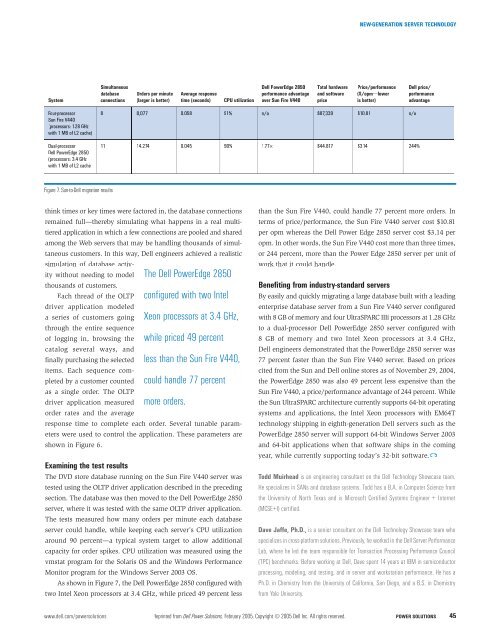Dell Power Solutions
Dell Power Solutions
Dell Power Solutions
- No tags were found...
Create successful ePaper yourself
Turn your PDF publications into a flip-book with our unique Google optimized e-Paper software.
NEW-GENERATION SERVER TECHNOLOGY<strong>Dell</strong> <strong>Power</strong>Edge 2850 Total hardware Price/performance <strong>Dell</strong> price/database Orders per minute Average response performance advantage and software ($/opm—lower performanceSystem connections (larger is better) time (seconds) CPU utilization over Sun Fire V440 price is better) advantageFour-processor 8 8,077 0.058 91% n/a $87,339$10.81 n/aSun Fire V440(processors: 1.28 GHzwith 1 MB of L2 cache)Dual-processor 11 14,2740.045 90% 1.77× $44,817 $3.14 244%<strong>Dell</strong> <strong>Power</strong>Edge 2850(processors: 3.4 GHzwith 1 MB of L2 cacheFigure 7. Sun-to-<strong>Dell</strong> migration resultsthink times or key times were factored in, the database connectionsremained full—thereby simulating what happens in a real multitieredapplication in which a few connections are pooled and sharedamong the Web servers that may be handling thousands of simultaneouscustomers. In this way, <strong>Dell</strong> engineers achieved a realisticsimulation of database activitywithout needing to modelthousands of customers.Each thread of the OLTPdriver application modeleda series of customers goingthrough the entire sequenceof logging in, browsing thecatalog several ways, andfinally purchasing the selecteditems. Each sequence completedby a customer countedas a single order. The OLTPdriver application measuredorder rates and the averageresponse time to complete each order. Several tunable parameterswere used to control the application. These parameters areshown in Figure 6.Examining the test resultsThe <strong>Dell</strong> <strong>Power</strong>Edge 2850configured with two IntelXeon processors at 3.4 GHz,while priced 49 percentless than the Sun Fire V440,could handle 77 percentmore orders.The DVD store database running on the Sun Fire V440 server wastested using the OLTP driver application described in the precedingsection. The database was then moved to the <strong>Dell</strong> <strong>Power</strong>Edge 2850server, where it was tested with the same OLTP driver application.The tests measured how many orders per minute each databaseserver could handle, while keeping each server’s CPU utilizationaround 90 percent—a typical system target to allow additionalcapacity for order spikes. CPU utilization was measured using thevmstat program for the Solaris OS and the Windows PerformanceMonitor program for the Windows Server 2003 OS.As shown in Figure 7, the <strong>Dell</strong> <strong>Power</strong>Edge 2850 configured withtwo Intel Xeon processors at 3.4 GHz, while priced 49 percent lessthan the Sun Fire V440, could handle 77 percent more orders. Interms of price/performance, the Sun Fire V440 server cost $10.81per opm whereas the <strong>Dell</strong> <strong>Power</strong> Edge 2850 server cost $3.14 peropm. In other words, the Sun Fire V440 cost more than three times,or 244 percent, more than the <strong>Power</strong> Edge 2850 server per unit ofwork that it could handle.Benefiting from industry-standard serversBy easily and quickly migrating a large database built with a leadingenterprise database server from a Sun Fire V440 server configuredwith 8 GB of memory and four UltraSPARC IIIi processors at 1.28 GHzto a dual-processor <strong>Dell</strong> <strong>Power</strong>Edge 2850 server configured with8 GB of memory and two Intel Xeon processors at 3.4 GHz,<strong>Dell</strong> engineers demonstrated that the <strong>Power</strong>Edge 2850 server was77 percent faster than the Sun Fire V440 server. Based on pricescited from the Sun and <strong>Dell</strong> online stores as of November 29, 2004,the <strong>Power</strong>Edge 2850 was also 49 percent less expensive than theSun Fire V440, a price/performance advantage of 244 percent. Whilethe Sun UltraSPARC architecture currently supports 64-bit operatingsystems and applications, the Intel Xeon processors with EM64Ttechnology shipping in eighth-generation <strong>Dell</strong> servers such as the<strong>Power</strong>Edge 2850 server will support 64-bit Windows Server 2003and 64-bit applications when that software ships in the comingyear, while currently supporting today’s 32-bit software.Todd Muirhead is an engineering consultant on the <strong>Dell</strong> Technology Showcase team.He specializes in SANs and database systems. Todd has a B.A. in Computer Science fromthe University of North Texas and is Microsoft Certified Systems Engineer + Internet(MCSE+I) certified.Dave Jaffe, Ph.D., is a senior consultant on the <strong>Dell</strong> Technology Showcase team whospecializes in cross-platform solutions. Previously, he worked in the <strong>Dell</strong> Server PerformanceLab, where he led the team responsible for Transaction Processing Performance Council(TPC) benchmarks. Before working at <strong>Dell</strong>, Dave spent 14 years at IBM in semiconductorprocessing, modeling, and testing, and in server and workstation performance. He has aPh.D. in Chemistry from the University of California, San Diego, and a B.S. in Chemistryfrom Yale University.www.dell.com/powersolutions Reprinted from <strong>Dell</strong> <strong>Power</strong> <strong>Solutions</strong>, February 2005. Copyright © 2005 <strong>Dell</strong> Inc. All rights reserved. POWER SOLUTIONS 45








